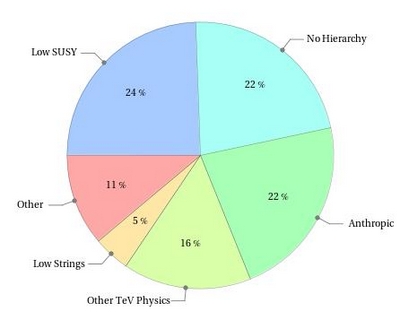---
Just five years ago, on the eve of the start of the Large Hadron Collider, most particle physicists - experimentalists and theorists alike - would have been willing to bet their left testicle or ovary on the fact that new physics would very soon be discovered, most likely Supersymmetric particles (if a suitable payoff had been offered in exchange).
We all know that the picture has changed dramatically since then: the failure of ATLAS and CMS to observe any hint of new physics in their large datasets -albeit at an energy almost halved from the design 14 TeV- has significantly cooled everybody down.
Seeing a statistics drawing a picture of the real way physicists nowadays think of the discovery potential of collider physics at the LHC and elsewhere, however, is quite different from catching the general feeling of colleagues in lab corridors or departments halls. Therefore I was quite intrigued by looking at a few pie charts produced by a polling of the participants to a workshop on the Higgs boson going on as we speak in Madrid.
Take for instance question (3) "Will the LHC eventually find new physics other than the Higgs boson?". I am sorry to be unable to prove it, but I strongly believe that 90% of my colleagues five years ago would have answered a resounding "YES". Now, 41% of the participants to the Madrid workshop say NO.
A more involved question concerned the hierarchy problem - the riddle concerning the unnaturally small mass of the Higgs boson, which apparently ends up this light because of unbelievably accurate cancellations of many unrelated quantum processes, each capable of raising its value by orders of magnitude: (1) "Concerning the hierarchy problem, which of these options is in your opinion closer to the truth?". Here the possible answers were many, and I need to post the original pie chart to best represent the mix of answers, which could be chosen from the following list:
a) Low energy SUSY solves the hierarchy problem.
b) There is no hierarchy problem, it is a misinterpretation of how field theory works.
c) The hierarchy may be understood in the context of anthropic arguments, perhaps in connection with the existence of a landscape of string vacua.
d) There is new physics above the TeV scale (e.g. compositeness, Randal-Sundrum, some technicolor version).
e) There is a low scale string theory above a few TeV.
f) Other
As you can see above, there is no consensus. Opinions vary and are equally split between the alternative possibilities. Worth noting is that answer (b) (the one I would choose, incidentally) has as many supporters as answer (a). Low-energy Supersymmetry has indeed lost much of its appeal, and apparently this has caused many to reconsider the hierarchy problem and reason that it might just be a misinterpretation on our part.
Also interesting, although not directly related to the results so far produced by the LHC, is the answer to question (6) "Do you think that String Theory will eventually be the ultimate unified theory?" (my answer: NO). Here we see a funny split between believers (YES - 27%) and sceptics (NO - 27%); however the question foresaw a third answer: "it is a step" in the right direction. This is what the remaining 44% voted (I should mention that physicists at the conference were in majority theorists, a fact which is more relevant to this answer than to others IMHO).
I suggest you to visit the web site of the poll to see answers to the other interesting questions that were asked in Madrid. And I also suggest you to write below what your answers are to those questions - it would be fun to compare what scientists and non-scientists believe. If you do, please specify if you are a particle physicist (theorist or experimentalist) or not, and provide at least your answers to the three questions above; the other questions you might want to answer are:
2) "Will the LHC and/or the ILC eventually detect non-standard properties of the Higgs boson ?"
(my answer: NO)
4) "Will dark matter (either WIMPS, axions, or other) be detected in the course of the next decade ?" (my answer: NO - but by a small margin; had they said "20 years" I'd answer yes...).
Question 5 is a bit too technical for this blog, but you're welcome to answer that one too... "Will we eventually measure non-Gaussianities or tensor modes or other cosmological new effects?"
Have fun!




Comments